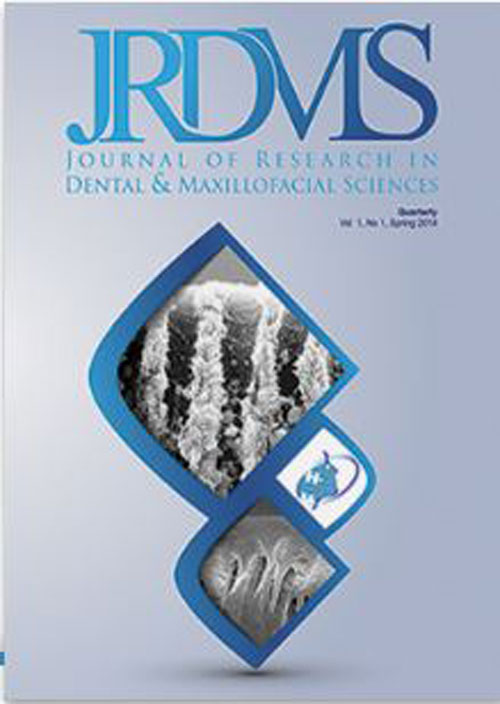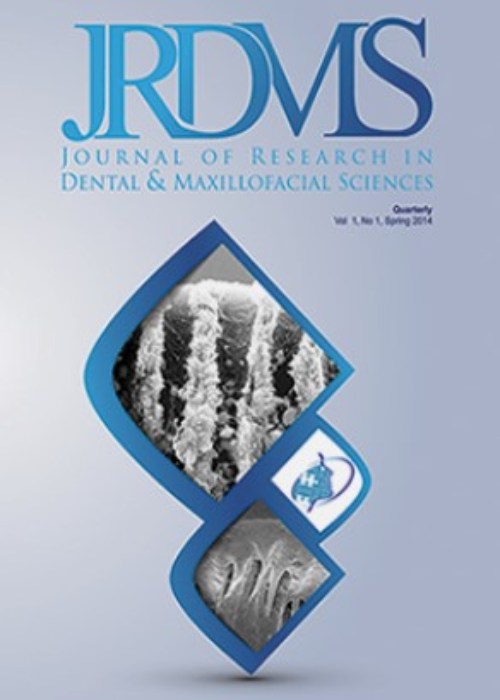فهرست مطالب

Journal of Research in Dental and Maxillofacial Sciences
Volume:6 Issue: 4, Autumn 2021
- تاریخ انتشار: 1400/07/26
- تعداد عناوین: 7
-
-
Pages 1-7Background and Aim
This study assessed the effects of cyclic loading on screw loosening, vertical misfit, and microleakage at the fixture-angulated abutment interface.
Materials and MethodsThis in vitro study evaluated 12 implants in two groups (n=6). The implants were mounted in self-cure acrylic resin. The abutment screw was torqued to 30 N/cm by a digital torque-meter and re-torqued after 5 min. Six points at the fixture-abutment interface were inspected under a stereomicroscope (x75 magnification), and the distance between the two reference points was measured. Six implant-abutment assemblies then underwent cyclic loading (75 N, 1 Hz, 500,000 cycles) while the remaining six (control group) were stored at room temperature. The distance was measured again at the same 6 points after cyclic loading. Vertical misfit was calculated by subtracting the before and after values. The torque loss was measured by a digital torque-meter. The assemblies were then immersed in fuchsine and incubated at 37°C for 24 h. Next, the abutment was unscrewed and the fixtures were cut in half. The penetration depth of fuchsine was measured at 3 points of each fixture half under a stereomicroscope at x75 magnification, and the mean of the six measurements (entire fixture) was reported as the microleakage score of each sample. Data were analyzed using t-test.
ResultsCyclic loading significantly increased the misfit (P=0.001) and microleakage (P=0.01), and decreased the detorque value (P=0.04). No case of screw loosening was noted in any group.
ConclusionCyclic loading significantly increases the vertical misfit, microleakage, and torque loss.
Keywords: Dental Implants, Dental Implant-Abutment Design, Dental Leakage -
Effect of Smear Layer on Penetration Depth of Methylene Blue and Curcumin into Root Dentinal TubulesPages 8-13Background and Aim
Methylene blue and curcumin are effective photosensitizers for inactivation of bacteria. This study assessed the penetration depth of methylene blue and curcumin in presence/absence of smear layer into dentinal tubules.
Materials and MethodsThirty-two human central and lateral incisors were included in this experimental study. The initially prepared specimens were randomly allocated to 4 experimental groups: Group 1: methylene blue with smear layer, group 2: methylene blue without smear layer, group 3: curcumin with smear layer, group 4: curcumin without smear layer. Root specimens were sectioned by a diamond disc at 4 and 8 mm from the apex to obtain apical, middle, and coronal sections. The mean penetration depth was measured at the buccal, mesial, distal and palatal areas on cross sections. ANOVA was used to assess the effect of photosensitizer type, smear layer, and root level on penetration depth. Pairwise comparisons were performed by the Student’s t-test.
ResultsThe maximum penetration depth was in the apical third in group 2 (0.98±0.25 mm) and the minimum penetration depth was in the coronal third in group 1 (0.21±0.15 mm); this difference was significant (P=0.001). Smear layer removal from the apical and middle thirds was correlated with higher photosensitizer penetration depth (P=0.000) but this difference was not significant in the coronal third (P=0.6). Curcumin had significantly greater penetration depth in presence of smear layer in all three parts compared with methylene blue (P<0.05).
ConclusionCurcumin can penetrate more into dentinal tubules than methylene blue in presence of smear layer.
Keywords: Curcumin, Dentin, Methylene Blue, Photosensitizing Agents, Smear Layer -
Pages 14-17Background
Compressive strength of acrylic resin base is an effective factor on durability of a prosthesis. The purpose of this in vitro study was to compare the compressive strength of three different types of heat-cure acrylic resins.
Materials and MethodsIn this in vitro experimental study, 60 acrylic samples were fabricated from Acropars, Acrosun, and Meliodent acrylic resins (n=20 from each). The specimens were placed in a universal testing machine and force was applied until their fracture. The load at fracture was recorded as the compressive strength. Data were analyzed using one-way ANOVA followed by the Tukey’s test.
ResultsThe mean compressive strength was 80.6 ± 6.9, 85.6 ± 6.9, and 71.9 ± 5.3 MPa for Acropars, Acrosun, and Meliodent, respectively. The compressive strength of Acrosun was significantly higher than that of other groups (P=0.047).
ConclusionIn general, the results showed that the highest and the lowest compressive strength values were related to Acrosun and Meliodent, respectively. These results indicated the optimal compressive strength of Iranian acrylic resins.
Keywords: Acrylic, Comprehensive Strength, PMMA, Heat Cure -
Pages 18-22Background and Objectives
Complete debridement of the root canal system is imperative for successful endodontic treatment. This study compared apical extrusion of debris following the use of different brands of ProTaper system.
Materials and MethodsThis in vitro experimental study was conducted on 80 extracted mandibular molars. After access cavity preparation, working length was determined by a #10 K-file. The teeth were mounted in an experimental setup as explained by Myers and Montgomery and were randomized into 4 groups (n=20) for root canal instrumentation with ProTaper Universal (PTU), Dia-PT file (DPT), PathMax Pro (PMP), and hand files. The root canals were irrigated with double distilled water after using 2 files. After preparation, the debris collecting tubes were separated from the setup. Debris adhering to root surface was also collected by rinsing the canals with 1 mL of double distilled water. The tubes were incubated at 70°C for 5 days. Dried debris was weighed and subtracted from the weight of empty tubes. Data were analyzed by ANOVA.
ResultsThe extruded debris in PTU group was significantly higher than that of DPT and PMP groups (P<0.05). The extruded debris in DPT group was significantly lower than that in PTU and hand file groups (P<0.05). The extruded debris in hand file group was significantly higher than DPT and PMP groups (P<0.05). The extruded debris in PMP group was significantly lower than PTU and hand file groups.
ConclusionPTU caused maximum and PMP caused minimum extrusion of debris.
Keywords: Root canal Therapy, Smear Layer, Root Canal Preparation -
Pages 23-28Background
General familiarity with medical ethics sometimes does not meet the needs of dentists. The aim of this study was to evaluate the ethical challenges faced by senior dental students and dentists.
MethodsIn this cross-sectional study, 50 senior dental students and 50 dentists were selected from Yazd city, Iran. A questionnaire with three domains (demographic information, hypothetical scenarios, and some three-choice questions about ethical issues) was used to collect data, and the data were analyzed by the Chi-square test.
ResultsThe mean age of students and general dentists was 24±2 and 30±2 years, respectively; 42% of the respondents were males, and 58% were females. Except for one item (dentistchr('39')s right to refuse treatment) (P<0.05), no significant difference was found between the two groups (P>0.05). The most common challenges faced by the participants were compromising treatment due to cost issues (77.1% of students and 71.4% of dentists) and noticing sub-standard treatments performed by other dentists (64% of students and 58% of dentists). Unawareness about the right way to criticize other dentists was the least commonly reported challenge (28% of students and 36.7% of dentists). A significant difference was found in the frequency of encountering sub-standard treatments performed by other dentists between the two groups (P=0.031). A significant difference in the frequency of a particular challenge between males and females was seen only in one item (disagreement with other colleagues on the appropriate treatment plan) and only in the students’ group (P= 0.040).
ConclusionThis study showed that dental practitioners had faced a variety of ethical challenges, that need to be addressed in dental education. However, the results of this study may not be generalizable to other cities.
Keywords: Ethics, Medical, Students, Dental, Dentists, Education -
Pages 30-38Backgrounds and Aim
The population of the elderly is growing, and oral health of this specific population is suboptimal because the prevalence of caries, xerostomia, edentulism, and oral cancer has increased among them. Impaired oral health may cause many problems and negatively affect the quality of life (QoL). Due to the increased need for preventive and restorative dental procedures with aging, effective strategies must be implemented in this respect. Thus, it is necessary to assess the oral health status and dental care needs of the geriatric population.
Materials and MethodsA literature search was conducted for studies published between 2015 and 2020 in the PubMed, Nature, Wiley, Science Direct and Google Scholar. Of 72 articles identified, 26 articles that were case reports and case series or had irrelevant titles or keywords were excluded, and 46 articles remained for data extraction.
ResultsThe most common oral problems in the elderly included xerostomia, oral pain, impaired deglutition, and mastication problems. Also, they suffered from edentulism, orofacial pains, pneumonia, and cognitive problems. Thus, they may need special dental care.
ConclusionProvision of dental care must be promoted to ensure that older people have appropriate access to oral health services. Many items affect the oral health-related quality of life (OHRQoL) of the elderly. Thus, dentists, dental hygienists, caregivers, and geriatricians must focus on improving the elderly’s oral health status. Oral health promotion programs in the elderly can decrease their oral problems and improve their OHRQoL.
Keywords: Oral Health, Aged, Dental Care, Preventive Health Services -
Pages 39-47Background and Aim
The most common etiology of gingivitis is accumulation of bacterial plaque. The complete removal of microbial plaques by mechanical procedures is not possible in some situations, for example the aged and disabled patients, might not be capable of removing the bacterial plaques properly. And also chemical mouthwashes have some adverse effects. Therefore, finding a new treatment approach would be helpful. Global focus on the use of herbal medicine in the treatment of different health conditions has been rising. Present study aimed at searching and gathering scientific evidence of medicinal herbs to treat gingivitis and periodontitis.
Materials and MethodsThis article is a review of an electronic search of the literature which was conducted mostly through PubMed, Scopus, Google Scholar, and Wiley online library databases. Studies were considered for inclusion if they evaluated medicinal herbs affecting gingival and periodontal inflammation or periodontal pathogens.197 full text article were evaluated and finally, based on the inclusion criteria 22 articles were selected.
ResultsThere are various medical herbs with antibacterial and anti-inflammatory properties, which can significantly reduce gingival and periodontal inflammation, bleeding on probing (BOP), plaque index (PI), probing depth (PD) and levels of major periodontal pathogens and promote clinical attachment level (CAL) gain.
ConclusionIntroduced herbal products could be an efficient and safe alternative to chemical products.
Keywords: Anti-inflammatory agents, Gingivitis, Herbal, Mouthwashes, Periodontal Diseases


